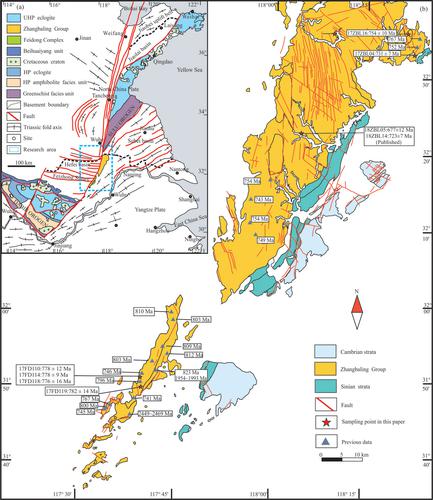当前位置:
X-MOL 学术
›
Acta Geol. Sinica Engl. Ed.
›
论文详情
Our official English website, www.x-mol.net, welcomes your feedback! (Note: you will need to create a separate account there.)
Neoproterozoic Crustal Reworking and Growth in the Zhangbaling Uplift, Tan–Lu Fault Zone: Evidence from the Feidong Complex and Zhangbaling Group
Acta Geologica Sinica-English Edition ( IF 3.3 ) Pub Date : 2020-12-09 , DOI: 10.1111/1755-6724.14604 Manlan NIU 1 , Qianru CAI 1 , Qi WU 1 , Xiaoyu YUAN 1 , Yi SUN 1 , Xiucai LI 1 , Chen LI 1 , Guang ZHU 1 , Zhensheng LI 1 , Shuai ZHANG 1
Acta Geologica Sinica-English Edition ( IF 3.3 ) Pub Date : 2020-12-09 , DOI: 10.1111/1755-6724.14604 Manlan NIU 1 , Qianru CAI 1 , Qi WU 1 , Xiaoyu YUAN 1 , Yi SUN 1 , Xiucai LI 1 , Chen LI 1 , Guang ZHU 1 , Zhensheng LI 1 , Shuai ZHANG 1
Affiliation

|
Intensive mid‐Neoproterozoic magmatism is the salient feature of the Yangtze Block, preserving abundant information about crustal reworking and growth. Zircon U–Pb–Lu–Hf isotope analysis was performed on material from the Feidong Complex (FDC) and Zhangbaling Group (ZBLG) of the Zhangbaling Uplift, in order to determine the age and magmatic source of the Neoproterozoic igneous rocks as well as the detrital provenance for the sedimentary rocks, to further provide important data for understanding the mid‐Neoproterozoic crustal evolution of the Northeast Yangtze Block. The amphibolite and gneissic granites in the Feidong Complex (FDC) gave similar protolith ages of 782–776 Ma. The synmagmatic zircons exhibited variable negative ∊Hf(t) values of –26.9 to –8.3. Early (ca. 2.4 Ga) to late Paleoproterozoic (ca. 2.0–1.9 Ga) inherited zircons were found in the gneissic monzogranite, with negative ∊Hf(t) values of –11.2 to –7.2, indicating strong reworking of the ancient crustal materials of the Northeast Yangtze Block. Whereas the amphibolites represent minor crustal growth through emplacement of continental rifting‐related mafic magmas. The quartz–keratophyres in the Xileng Formation of the ZBLG in contrast systematically yield young protolith crystallization ages of 754–727 Ma with high ∊Hf(t) values of –2.0 to +5.6, indicating their derivation from the reworking of juvenile crustal materials. The detrital zircons from the metasiltstone in the Beijiangjun Formation yield variable 206Pb/238U ages (871–644 Ma) with a peak age at 741 ± 11 Ma and ∊Hf(t) values of –4.3 to +5.3, which is consistent with those of the Xileng Formation, but distinct from the FDC, indicating that the provenance of the metasiltstone is primarily the underlying Xileng Formation. The mid‐Neoproterozoic igneous and sedimentary rocks of the Zhangbaling Uplift were products from continental rifting zones along the northern margin of the Yangtze Block, situated in different positions from the Susong Complex and the Haizhou Group. The transition from ancient to juvenile crustal sources for felsic magmatic rocks is attributed to gradually increased crustal extension during continental rifting.
中文翻译:

bal庐断裂带张巴陵隆起的新元古代地壳重塑和生长:来自肥东联合体和张巴陵群的证据
新生代中期强烈的岩浆作用是扬子地块的显着特征,它保留了有关地壳返工和生长的大量信息。为了确定新元古代火成岩以及新元古代火成岩的年龄和岩浆源,对锆石的U–Pb–Lu–Hf同位素进行了分析,研究对象为张巴陵隆起的肥东复合体(FDC)和张巴陵群(ZBLG)。沉积岩碎屑物源,为进一步了解东北扬子地块中新元古代地壳演化提供重要数据。Feidong Complex(FDC)中的角闪石和片麻岩花岗岩的原生岩年龄相似,为782–776 Ma。所述synmagmatic锆石显示出可变负ε的Hf(吨)–26.9至–8.3的值。早期(约2.4 Ga)的古元到晚(约2.0-1.9 Ga)的在长花岗岩片麻岩发现继承锆,具有负ε的Hf(吨的-11.2至-7.2)值,这表明古地壳物质的强返工东北扬子地块。而角闪石代表着与大陆裂谷有关的镁铁质岩浆的进入,地壳生长较小。相比之下,ZBLG西冷组的石英-角砾岩系统地产生了高∊ Hf(t)值–2.0到+5.6,表示它们是从幼年地壳材料的返工中得出的。从Beijiangjun形成产量变量metasiltstone碎屑锆石206的Pb / 238 ù年龄(871-644 Ma)的有峰值年龄741±11 Ma和ε的Hf(吨)的值–4.3至+5.3,与西冷组的值一致,但与FDC不同,这表明偏粉砂岩的物源主要是潜在的西冷组。张坝岭隆起的中新元古代火成岩和沉积岩是来自扬子地块北缘的陆相裂谷带的产物,位于苏松综合体和海州群的不同位置。长英质岩浆岩从古代地壳向青少年地壳的过渡归因于大陆裂谷过程中地壳延伸的逐渐增加。
更新日期:2020-12-29
中文翻译:

bal庐断裂带张巴陵隆起的新元古代地壳重塑和生长:来自肥东联合体和张巴陵群的证据
新生代中期强烈的岩浆作用是扬子地块的显着特征,它保留了有关地壳返工和生长的大量信息。为了确定新元古代火成岩以及新元古代火成岩的年龄和岩浆源,对锆石的U–Pb–Lu–Hf同位素进行了分析,研究对象为张巴陵隆起的肥东复合体(FDC)和张巴陵群(ZBLG)。沉积岩碎屑物源,为进一步了解东北扬子地块中新元古代地壳演化提供重要数据。Feidong Complex(FDC)中的角闪石和片麻岩花岗岩的原生岩年龄相似,为782–776 Ma。所述synmagmatic锆石显示出可变负ε的Hf(吨)–26.9至–8.3的值。早期(约2.4 Ga)的古元到晚(约2.0-1.9 Ga)的在长花岗岩片麻岩发现继承锆,具有负ε的Hf(吨的-11.2至-7.2)值,这表明古地壳物质的强返工东北扬子地块。而角闪石代表着与大陆裂谷有关的镁铁质岩浆的进入,地壳生长较小。相比之下,ZBLG西冷组的石英-角砾岩系统地产生了高∊ Hf(t)值–2.0到+5.6,表示它们是从幼年地壳材料的返工中得出的。从Beijiangjun形成产量变量metasiltstone碎屑锆石206的Pb / 238 ù年龄(871-644 Ma)的有峰值年龄741±11 Ma和ε的Hf(吨)的值–4.3至+5.3,与西冷组的值一致,但与FDC不同,这表明偏粉砂岩的物源主要是潜在的西冷组。张坝岭隆起的中新元古代火成岩和沉积岩是来自扬子地块北缘的陆相裂谷带的产物,位于苏松综合体和海州群的不同位置。长英质岩浆岩从古代地壳向青少年地壳的过渡归因于大陆裂谷过程中地壳延伸的逐渐增加。



























 京公网安备 11010802027423号
京公网安备 11010802027423号